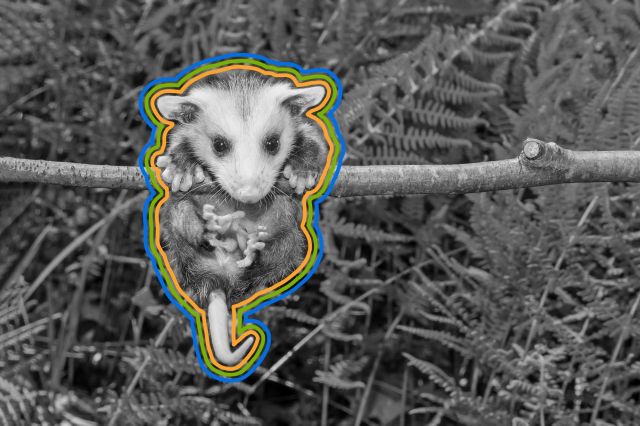
Kangaroos Are Great Swimmers
On land, a red kangaroo — the largest of the kangaroos — can leap along at more than 35 miles per hour and jump up to 6 feet high. They have a strong command of the water, too, and can even use their forepaws to drown potential predators.
A 1974 research paper described their profound natural instinct for swimming, and noted that red kangaroos observed in a pool reached speeds of about 1 meter (a little more than a yard) per second. Although both kangaroos in the pool had been raised in captivity and had never swum before, it took them only 10 to 15 seconds to adapt and start swimming in a pattern that they wouldn’t use on land, using their back legs to stay afloat. Their forward motion came from stroking using their front legs, with the digits of their paws fully extended. Sweeping their tails horizontally from side to side like the back fin of a fish also helped propel them forward (on land, kangaroo tails typically move vertically).
Kangaroos of multiple species have been observed swimming in the wild, with at least one swimming about 2 miles when threatened. On YouTube, you can see kangaroos swimming along an open coastline and in more sheltered waters alike.

Wombats’ Teeth Don’t Stop Growing
Wombats have a lot in common with groundhogs and other rodents found in North America, but these Australian beasts are marsupials and significantly larger, at about 31 to 47 inches long. They all spend a lot of time gnawing on stuff, though, so wombats have very similar teeth: They’re rootless, and they never stop growing.
The common wombat has two pairs of large incisors, one at the top and the other at bottom of their jaw, and 16 molars tucked into its cheeks. As long as wombats stick to their regular diet of highly abrasive grasses, their teeth grind down as they grow — although some wombats, especially those in captivity, require special dental intervention to keep things from getting out of hand after eating less fibrous foods.

Some Marsupials Don’t Have Pouches
A fully functional pouch is not a prerequisite for being a marsupial — it’s just a common convenience for animals that give birth to babies that aren’t fully developed — so some joeys are left to just cling to their mothers’ teats and hope for the best. Some species only have the remnants of a pouch.
Short-tailed opossums, a species native to Brazil that’s between the size of a mouse and a rat, have no pouch at all. When their embryos emerge, they don’t even have limbs yet, so they use their little nubs (with tiny claws!) to scramble for a nipple and attach. A seal forms that holds the baby on, and the mother can retract her nipples into her body, holding the babies close until they’re ready to detach.
More Interesting Reads

Water Opossums Have Built-In Swimsuits
The yapok, also called a water opossum, is native to the lakes of Mexico, Central America, and South America, and has two kinds of pouches: one on male yapoks and one on females. Male yapoks’ pouches don’t serve quite the same reproductive purpose, though. When they’re swimming, moving quickly, or diving, they have a muscle that can pull their pouch up to protect their reproductive equipment and keep it dry.
Female yapok pouches are also pretty cool, though: They create a sealed compartment that can keep the babies inside dry while mom is swimming.

Opossums Have a Natural Immunity to Rabies
Because of their tendency to crawl around in the trash and hiss at people open-mouthed and drooling, opossums are often thought to carry rabies. Not only are the creatures bluffing when they pretend to be vicious, but it’s actually exceedingly rare for them to contract rabies, possibly because they have a much lower body temperature than other warm-blooded animals like raccoons and bats.
Opossums may look scary at times, but they’re one of the better scavengers to find in your backyard. They rarely eat live chickens, but do eat garden pests, small rodents, fruit that has fallen from trees, and messes left behind by less courteous passing critters.

Australia Has “Easter Bilbies” in Addition to Easter Bunnies
Easter Bunnies make sense in Europe and the Americas, which have native rabbit species. In Australia, not so much: Rabbits, which were brought from England in the 1800s, are an incredibly invasive species Down Under.
Bilbies, on the other hand, are native to Australia. They’re marsupials about the size of rabbits, with similarly long ears and an adorable face, along with a shrew-like snout. They’re also endangered, thanks in part to the interloping rabbits that started pushing bilbies out of their burrows, leaving them vulnerable to cat and fox attacks that were already on the rise with the arrival of European settlers.
Enter the Easter Bilby, a now-decades-long Australian tradition. It has its origins in 1968, when a nine-year-old girl wrote a story called “Billy the Aussie Easter Bilby,” which she later published. It really started catching on in the 1990s, though, after the Foundation for Rabbit-Free Australia started a campaign to promote native wildlife. Candymakers caught on, and now you can find Easter Bilbies on Australian shelves every year, often raising money for preservation groups.
Easter Bunnies are still sold in Australia, too — but the Easter Bilby has caught on as well, introducing new generations to this uniquely Australian animal.

Marsupial Mole Sightings Are (Very) Rare
Marsupial moles, a pair of species native to Australia called kakarratul and itjaritjari, really keep to themselves. Like standard moles, which evolved completely separately, they have no sense of sight (moles have no eyes; marsupial moles have no optic nerves and only vestigial lenses) and live their lives digging underground. Unlike moles, they don’t leave any trail behind, instead moving seamlessly through soft desert sand as if they’re swimming. As is the case with other burrowing marsupials, their pouch faces backward, which shields their babies from the dirt.
They live most of their lives underground, and not only do they leave little trace of where they’ve been, but they rarely show their silky golden faces above the surface. A mere sighting can be a newsworthy event. One Australian scientist estimates that humans see them above the surface only about 10 times a decade.











